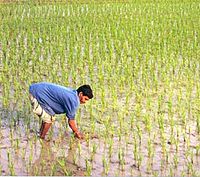
Photo from wikipedia
The soil exchange complex consists of colloidal materials on which ion exchange phenomena occur allowing it to attract, retain, and exchange elements that have opposite electric charges. Since their mineral… Click to show full abstract
The soil exchange complex consists of colloidal materials on which ion exchange phenomena occur allowing it to attract, retain, and exchange elements that have opposite electric charges. Since their mineral constituents (clay) and organic components (humus) are mainly of a negative nature retained or exchanged ion are predominantly cations. Historically, failing to monitor parameters like the exchange sodium percentage (ESP) has led to the permanent deterioration of soils which have become completely unproductive, largely reducing the sustainability of the agricultural systems. This study assesses how the sodium exchange capacity in irrigated soils differs from the rainfed ones through a sample survey that was carried out in the 15,031 ha of the Caia Irrigation Perimeter and adjacent areas, located in the municipalities of Elvas and Campo Maior, Portalegre District, Portugal where 14,280 georeferenced samples were collected from the top soil layer (0–20 cm), which were mixed 10 at a time so that each composite sample representing 11.1 ha. Then the samples were analyzed regarding the most relevant parameters for characterizing the soil exchange complex including the concentrations of exchanged bases and Cation Exchange Capacity (CEC). The results were arranged in a georeferenced grid with 1451 entries. Using classical statistical analysis and Geographic Information Systems (GIS) software, it was possible to relate the individual soil samples analyzed with the cultural system practiced (irrigated or rainfed) and the present soil group which permitted us to analyze the influence of the cultural system in the soil exchange complex. The distribution chart of the exchange sodium and CEC were created. The obtained results confirm a general decrease of CEC values and an increase of the exchangeable sodium content of irrigated explored soils when compared to the rainfed ones, putting forward noteworthy ideas not only regarding the necessary changes towards the sustainability of these irrigated agricultural landscapes, but also considering the impact of these productive techniques on different agricultural systems.
Journal Title: Sustainability
Year Published: 2017
Link to full text (if available)
Share on Social Media: Sign Up to like & get
recommendations!